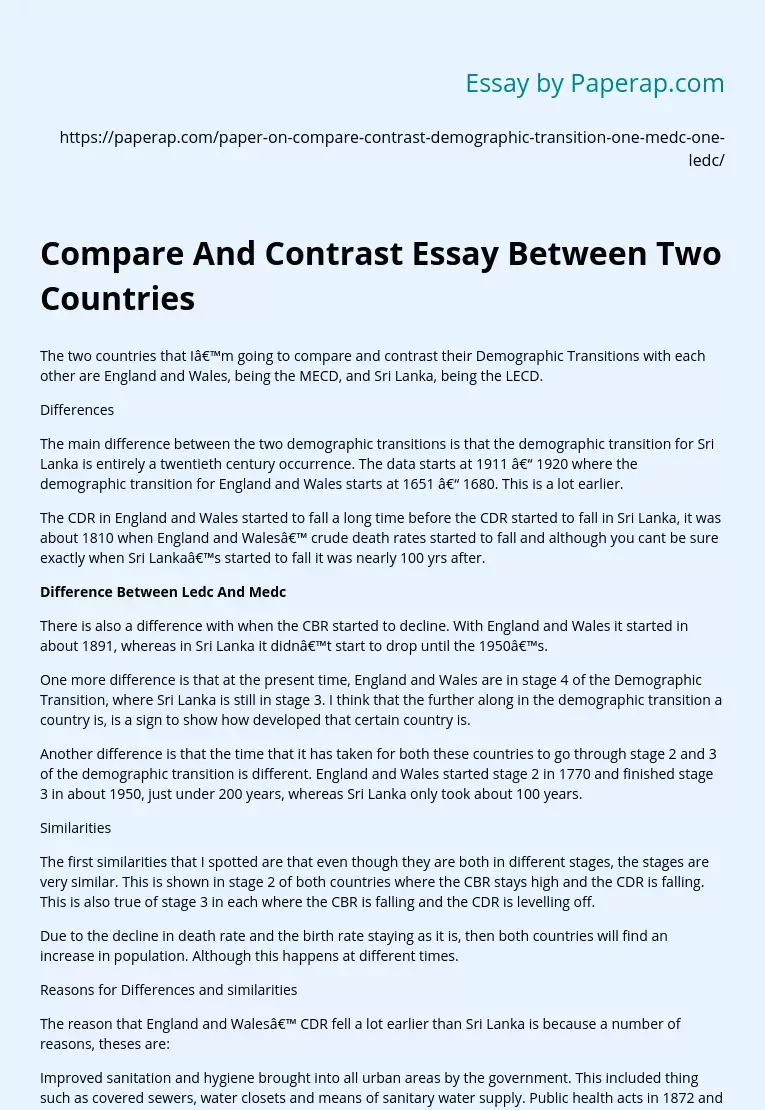Compare And Contrast Essay Between Two Countries
The two countries that I’m going to compare and contrast their Demographic Transitions with each other are England and Wales, being the MECD, and Sri Lanka, being the LECD.
Differences
The main difference between the two demographic transitions is that the demographic transition for Sri Lanka is entirely a twentieth century occurrence. The data starts at 1911 – 1920 where the demographic transition for England and Wales starts at 1651 – 1680. This is a lot earlier.
The CDR in England and Wales started to fall a long time before the CDR started to fall in Sri Lanka, it was about 1810 when England and Wales’ crude death rates started to fall and although you cant be sure exactly when Sri Lanka’s started to fall it was nearly 100 yrs after.
Difference Between Ledc And Medc
There is also a difference with when the CBR started to decline. With England and Wales it started in about 1891, whereas in Sri Lanka it didn’t start to drop until the 1950’s.
One more difference is that at the present time, England and Wales are in stage 4 of the Demographic Transition, where Sri Lanka is still in stage 3. I think that the further along in the demographic transition a country is, is a sign to show how developed that certain country is.
Another difference is that the time that it has taken for both these countries to go through stage 2 and 3 of the demographic transition is different. England and Wales started stage 2 in 1770 and finished stage 3 in about 1950, just under 200 years, whereas Sri Lanka only took about 100 years.
Similarities
The first similarities that I spotted are that even though they are both in different stages, the stages are very similar. This is shown in stage 2 of both countries where the CBR stays high and the CDR is falling. This is also true of stage 3 in each where the CBR is falling and the CDR is levelling off.
Due to the decline in death rate and the birth rate staying as it is, then both countries will find an increase in population. Although this happens at different times.
Reasons for Differences and similarities
The reason that England and Wales’ CDR fell a lot earlier than Sri Lanka is because a number of reasons, theses are:
Improved sanitation and hygiene brought into all urban areas by the government. This included thing such as covered sewers, water closets and means of sanitary water supply. Public health acts in 1872 and 1875 also helped, inspectors were also brought in for hygiene.
Improved food supply brought about by major innovations such as crop rotation, land draining and new farm machinery. With the improvements of communications it also became easier to transport the food to areas of shortage.
Reduced impact of infectious disease also helped to lower the CDR.
There were many medical advances that made a difference practically in the late 19th century after the national heath service was started in 1946.
Whereas in Sri Lanka the CDR fell because of some different reasons, these are:
There was control of Malaria brought in which contributed 25-40% of all mortality declines. This wasn’t started until 1947 when a DDT scheme got under way.
There was better health care brought in, between 1938-48 the number of hospitals doubled from 115 to 246. There was an increase in foreign aid, which also boosted the health care in the country.
Growth in the economy took place between1947-52 due to a rise in price for plantation products, which resulted in a higher budget for health care.
Once that malaria had been brought under control, zones that once couldn’t be farmed due to the malaria before could now be used and this provided more nutrition, thus decreasing CDR in the country.
The reason why England and Wales’ CBR fell before Sri Lanka’s can once again be split up into smaller reasons, theses are:
In 1842 all women and children were excluded from the mines and by 1906 no children under the age of 11 were working. This combined with the compulsory education act of 1867 meant that children were no longer seen as an economic asset.
Economic changes such as more women entering work and thus not having children.
The growth of ideas such as the publishing of leaflets about contraception also contributed to the decline in CBR. Also the availability of the contraception made a difference.
The decline in mortality had an effect also. As more children survived, women needed to have fewer births to achieve the same family size.
This is just some of the main similarities and differences between a MEDC and a LEDC, there are many more smaller ones as well as what I’ve already put.
Compare And Contrast Essay Between Two Countries. (2019, Dec 05). Retrieved from https://paperap.com/paper-on-compare-contrast-demographic-transition-one-medc-one-ledc/

